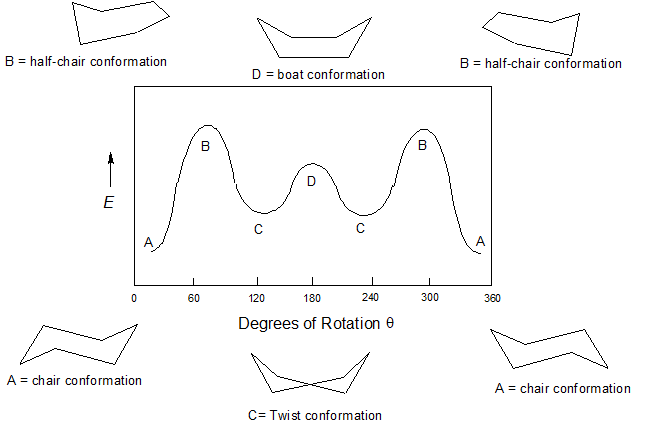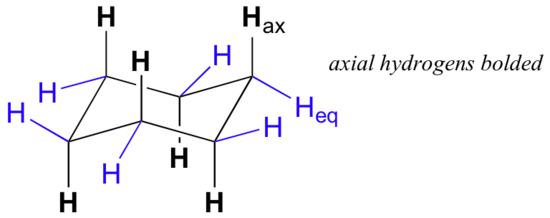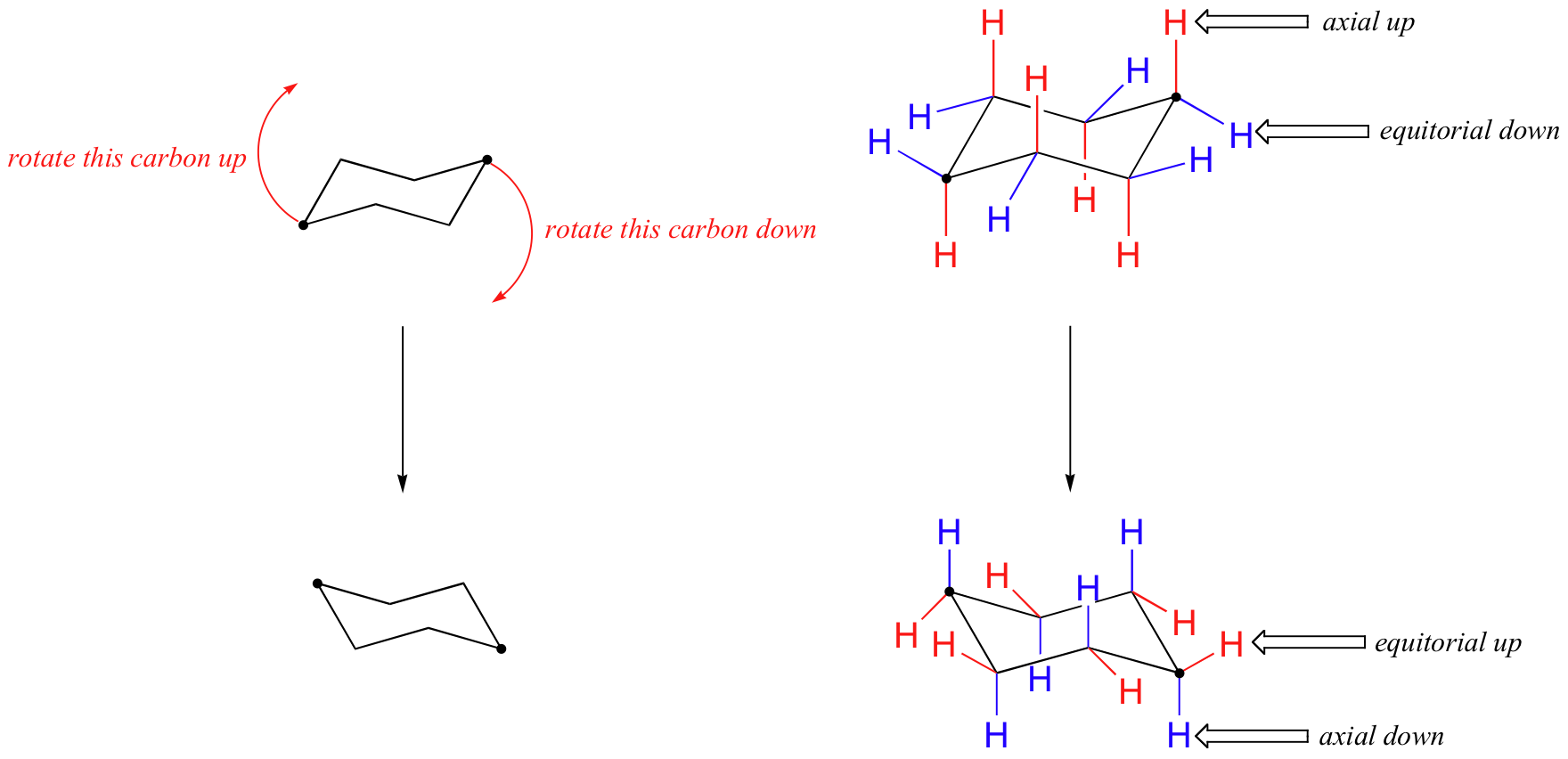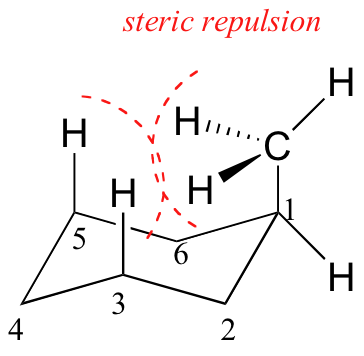How To Draw Chairs Organic Chemistry
4.7: Cyclohexane Conformations
- Page ID
- 44670
Learning Objective
- draw cyclohexane conformations (chair & boat)
- correlate energies of conformations with rotational energy diagrams and predict the most stable conformations for cyclohexane
Introduction
Rings larger than cyclopentane would have angle strain if they were planar. Yet, this strain, together with the eclipsing strain inherent in a planar construction, tin can be relieved by puckering the ring. Cyclohexane is a good case of a carbocyclic arrangement that nearly eliminates eclipsing and angle strain past adopting not-planar conformations. Cycloheptane and cyclooctane have greater strain than cyclohexane, in big part due to transannular crowding (steric hindrance by groups on contrary sides of the ring).
Cyclohexane Conformations (aka Chair Flips)
Cyclohexane is speedily rotating between the ii most stable conformations known equally the chair conformations in what is called the "Chair Flip" shown below.

Several other notable cyclohexane conformations occur during the transition from one chair conformer to the other - the boat, the twist, and the half-chair. The relative energies of the conformations is a direct reflection of their relative stabilities. These structural and energetic relationships are summarized in the conformational energy diagram for cyclohexane below.

The Chair Conformation - a closer expect
Since the chair conformation has the lowest potential free energy, it is the most relevant to the conformation of cyclohexane. On careful examination of a chair conformation of cyclohexane, we find that the twelve hydrogens are not structurally equivalent. Six of them are located about the periphery of the carbon ring, and are termed equatorial. The other six are oriented above and below the approximate plane of the band (iii in each location), and are termed axial because they are aligned parallel to the symmetry centrality of the ring.

In the figure in a higher place, the equatorial hydrogens are colored bluish, and the axial hydrogens are in bold. Since there are two equivalent chair conformations of cyclohexane in rapid equilibrium, all twelve hydrogens have l% equatorial and fifty% centric character. The figure beneath illustrates how to catechumen a molecular model of cyclohexane between ii dissimilar chair conformations - this is something that you lot should practice with models. Detect that a 'ring flip' causes equatorial hydrogens to become axial, and vice-versa.

How to draw stereo bonds ("upwardly" and "down" bonds) 
There are various ways to testify these orientations. The solid (dark) "up wedge" I used is certainly common. Some people use an analogous "down wedge", which is low-cal, to indicate a down bond; unfortunately, in that location is no agreement as to which mode the wedge should bespeak, and you are left relying on the lightness of the wedge to know it is "down". The "down bail" avoids this wedge ambiguity, and just uses some kind of light line. The down bond I used (e.g., in Figure 5B) is a dashed line; IUPAC encourages a series of parallel lines, something like  What I did is a variation of what is recommended by IUPAC:
What I did is a variation of what is recommended by IUPAC:
- In ISIS/Draw, the "up wedge" and "down bond" that I used, along with other variations, are bachelor from a tool button that may be labeled with any of them, depending on almost recent use. It is located directly beneath the tool button for ordinary C-C bonds.
- In Symyx Draw, the "upwards wedge" and "downwardly bond", forth with other variations, are bachelor from a tool button that may be labeled with whatever of them, depending on nigh recent employ. It is located directly beneath the "Chain" tool button.
- ChemSketch provides upward and down wedges, simply not the unproblematic upwardly and down bonds discussed above. The wedges are available from the second toolbar beyond the top. For an expanded word of using these wedges, come across the section of my ChemSketch Guide on Stereochemistry: Wedge bonds.
As always, the information provided on these pages in intended to aid you get started. Each program has more options for drawing bonds than discussed here. When you lot experience the need, await effectually!
How to Depict chairs 
Nigh of the structures shown on this folio were drawn with the costless program ISIS/Describe. I have posted a guide to help you get started with ISIS/Depict. ISIS/Draw provides a unproblematic cyclohexane (6-ring) hexagon template on the toolbar across the top. It provides templates for diverse 6-band chair structures from the Templates menu; cull Rings. At that place are templates for unproblematic chairs, without substituents (eastward.g., Fig 1B), and for chairs showing all the substituents (e.g., Fig 2B). In either case, you tin can add, delete, or change things as you wish. Various kinds of stereo bonds (wedges and confined) are available past clicking the left-side tool push that is merely below the regular C-C unmarried bail button. Information technology may have a wedge shown on it, but this volition vary depending on how it has been used. To choose a type of stereo bond, click on the push and concord the mouse click; a new menu will announced to the right of the push button.
The gratuitous drawing program Symyx Depict, the successor to ISIS/Draw, provides similar templates and tools. A basic chair structure is provided on the default template bar that is shown. More options are available past choosing the Rings template. Meet my page Symyx Draw for a general guide for getting started with this plan.
The free cartoon program ChemSketch provides similar templates and tools. To discover the special templates for chairs, go to the Templates menu, choose Template Window, so choose "Rings" from the drop-down carte du jour nearly upper left. See my page ChemSketch for a full general guide for getting started with this programme.
If you desire to draw chair structures by hand (and if you are going on in organic chemical science, you should)... Exist conscientious. The precise zigs and zags, and the angles of substituents are all important. Your textbook may offering you some hints for how to describe chairs. A brusk item in the Journal of Chemical Instruction offers a dainty trick, showing how the chair can be thought of as consisting of an Thou and a W. The commodity is Five Dragojlovic, A method for drawing the cyclohexane ring and its substituents. J Chem Educ 78:923, 7/01. (I thank M Farooq Wahab, Chemistry, Univ Karachi, for suggesting that this article be noted hither.)
Aside from drawing the basic chair, the cardinal points in adding substituents are:
- Axial groups alternate up and down, and are shown "vertical".
- Equatorial groups are approximately horizontal, merely really somewhat distorted from that, and then that the angle from the centric group is a chip more than than a right angle -- reflecting the common 109 degree bond angle.
- As cautioned before, it is usually easier to draw and meet what is happening at the four corners of the chair than at the two middle positions. Try to use the corners every bit much as possible.
Considering axial bonds are parallel to each other, substituents larger than hydrogen generally suffer greater steric crowding when they are oriented axial rather than equatorial. Consequently, substituted cyclohexanes volition preferentially adopt conformations in which the larger substituents presume equatorial orientation .

When the methyl group in the structure above occupies an axial position it suffers steric crowding by the two axial hydrogens located on the same side of the ring.

The conformation in which the methyl grouping is equatorial is more stable, and thus the equilibrium lies in this direction
Exercise
Questions
1. Consider the conformations of cyclohexane, chair, gunkhole, twist boat. Order them in increasing strain in the molecule.
two. Draw two conformations of cyclohexyl amine (CviH11NH2). Indicate axial and equatorial positions.
three. Draw the two isomers of i,iv-dihydroxylcyclohexane, identify which are equatorial and axial.
4. In the following molecule, label which are equatorial and which are axial, then depict the chair flip (showing labels 1,2,3).

- Answer
-
1. Chair < Twist Boat < Boat (nigh strain)
2.

3.

4. Original conformation: 1 = centric, 2 = equatorial, iii = axial
Flipped chair at present looks like this.

Source: https://chem.libretexts.org/Bookshelves/Organic_Chemistry/Map%3A_Organic_Chemistry_(Wade)/04%3A_Structure_and_Stereochemistry_of_Alkanes/4.07%3A_Cyclohexane_Conformations
Posted by: pursellthempailoved.blogspot.com


0 Response to "How To Draw Chairs Organic Chemistry"
Post a Comment